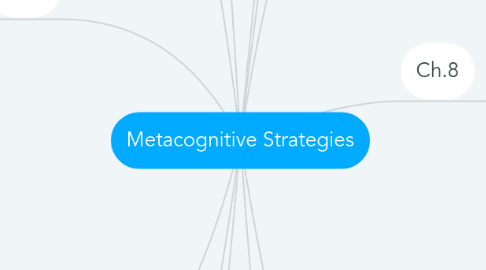
1. Ch.3
1.1. Emotional Intelligence
1.1.1. Awareness of one's emotions
1.1.2. Control of one's emotions
1.1.3. Knowing one's strengths and weaknesses
1.2. Improving E.I.
1.2.1. Find your strengths/weaknesses
1.2.2. Set reachable goals
1.2.3. Make a plan
1.2.4. Track your progress regularly
1.3. Different categories of E.I.
1.3.1. Intrapersonal skills
1.3.2. Interpersonal skills
1.3.3. Stress Management
1.3.3.1. g
2. Ch.4
2.1. The VARK
2.1.1. Visual
2.1.2. Auditory
2.1.3. Read/Write
2.1.4. Kinesthetic
2.2. Multiple Intelligences
2.2.1. Verbal/Linguistic
2.2.2. Logistic/Mathimatical
2.2.3. Visual/Spatial
2.2.4. Intrapersonal
2.2.5. Interpersonal
2.2.6. Musical/Rhythmic
2.3. Learning styles and teaching styles can conflict
3. Ch.5
3.1. Problem Solving
3.1.1. Deciding how to spend your time when 2 big assignments due on the same day
3.1.2. Understand the advantages/disadvantages of social media
3.2. Asking Questions
3.2.1. Think deeper
3.2.2. Question statements
3.2.3. Relate new knowledge to old knowledge
3.3. Examining Evidence
3.3.1. What am I being asked to belive
3.3.2. Does the evidence support the conclusion
3.3.3. Is it logical
4. Ch.7
4.1. Prepare for class
4.1.1. Do the assigned reading
4.1.2. Take advantage of extra resources provided
4.1.3. Get Organized
4.2. Participate in class
4.2.1. Listen Critically and Open Mindedly
4.2.2. Speak Up
4.3. Note taking formats
4.3.1. Cornell format
4.3.2. List Format
4.3.3. Paragraph Format
5. Ch.9
5.1. Test preparation
5.1.1. Ask about the test format
5.1.2. Make sure your notes are accurate with your instructor
5.1.3. Don't miss the class the day before the exam
5.2. Get a Tutor
5.3. Join a study group
6. Ch.11
6.1. Differences in college
6.1.1. Race
6.1.2. Age
6.1.3. Gender
6.1.4. Religion
6.1.5. Economic Status
6.1.6. Sexuality
6.1.7. Learning and Physical challenges
6.2. Student Ran Orginizations
6.2.1. Career/Major Group
6.2.2. Political/Activist Orginizations
6.2.3. Special Interest Groups
6.3. Challenge yourself to experience diversity
7. Ch.1
7.1. Determination, Resolve, Goal
7.2. Goal Setting
7.2.1. Identify personal strengths
7.3. establish goals for today, this week, and beyond
7.4. SMART Goals
7.4.1. Specific
7.4.2. Measurable
7.4.3. Attainable
7.4.4. Relevant
7.4.5. Time Frame
8. Ch.2
8.1. Prioritization
8.1.1. determine which tasks are most important
8.1.2. Use some sort of time management device (Planner, Calendar, etc.)
8.1.3. Don't overextend yourself
8.2. Overcoming Distractions
8.2.1. Become aware of your distractions
8.2.2. ask yourself how much control you have over those distractions
8.2.3. Find Solutions
9. Ch.6
9.1. Active Reading
9.1.1. Previewing
9.1.2. Marking
9.1.3. Reading with concentration
9.1.4. Reviewing
9.2. Outlining or Listing/Mapping
9.3. Book marking strategies
9.3.1. Read and think before marking
9.3.2. Take notes with marks
10. Ch.8
10.1. Memory
10.1.1. Short-term
10.1.2. Long-term
10.2. Deep Learning
10.2.1. Avoid multitasking
10.2.2. Work on reading memory
10.2.3. Understand the How and Why
10.3. Myths about Memory
10.3.1. Memory benefits from spending a long-time on something
10.3.2. Lots of memories clutter your memory
10.3.3. You only use 10% of your brain
11. Ch.10
11.1. Types of literacy
11.1.1. Computer Literacy
11.1.2. Media Literacy
11.1.3. Cultural Literacy
11.2. Becoming more literate
11.2.1. Know how to find the info you need
11.2.2. Learn how interpret info
11.2.3. Have a purpose for learning
11.3. Relevance Is it:
11.3.1. Introductory
11.3.2. Definitional
11.3.3. Analytical
11.3.4. Comprehensive
12. Ch.12
12.1. Creating a Budget
12.1.1. Gather info about your income
12.1.2. Share Expenses
12.1.3. Avoid unnecessary fees
12.2. Types of Aid
12.2.1. Grants
12.2.2. Scholarship
12.2.3. Merit Schlorship
12.2.4. Work-Study
12.2.5. Cooperative Education
12.3. Student Loans
12.3.1. Subsidized Federal Loans
12.3.2. Unsubsidized Federal Loans
12.3.3. PLUS Loans
12.3.4. Private Student Loans

